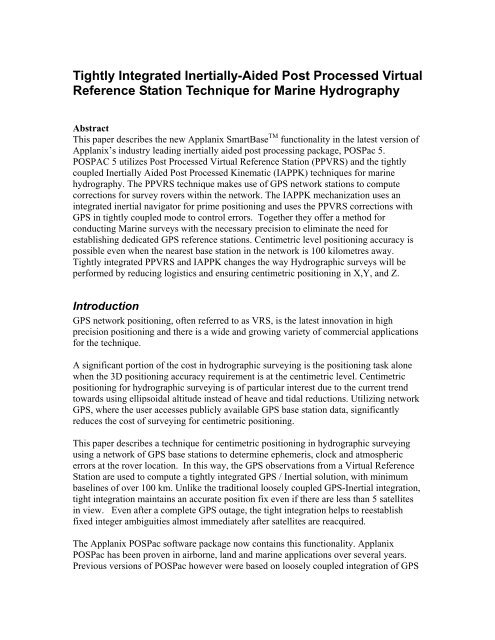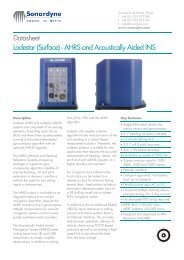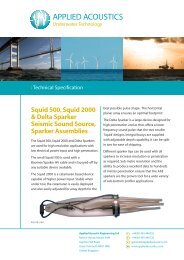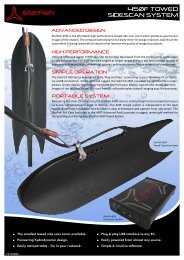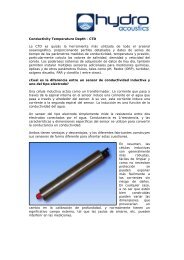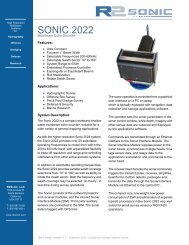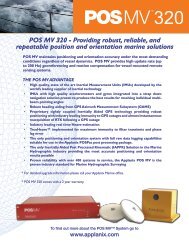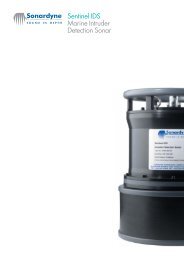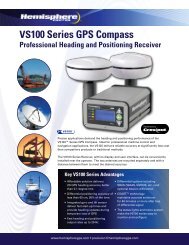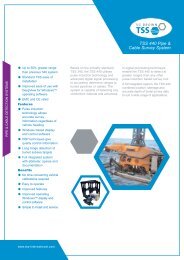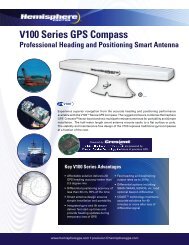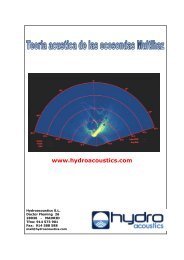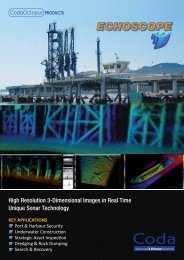POSPac 5.0 Marine - Applanix
POSPac 5.0 Marine - Applanix
POSPac 5.0 Marine - Applanix
You also want an ePaper? Increase the reach of your titles
YUMPU automatically turns print PDFs into web optimized ePapers that Google loves.
Tightly Integrated Inertially-Aided Post Processed Virtual<br />
Reference Station Technique for <strong>Marine</strong> Hydrography<br />
Abstract<br />
This paper describes the new <strong>Applanix</strong> SmartBase TM functionality in the latest version of<br />
<strong>Applanix</strong>’s industry leading inertially aided post processing package, <strong>POSPac</strong> 5.<br />
POSPAC 5 utilizes Post Processed Virtual Reference Station (PPVRS) and the tightly<br />
coupled Inertially Aided Post Processed Kinematic (IAPPK) techniques for marine<br />
hydrography. The PPVRS technique makes use of GPS network stations to compute<br />
corrections for survey rovers within the network. The IAPPK mechanization uses an<br />
integrated inertial navigator for prime positioning and uses the PPVRS corrections with<br />
GPS in tightly coupled mode to control errors. Together they offer a method for<br />
conducting <strong>Marine</strong> surveys with the necessary precision to eliminate the need for<br />
establishing dedicated GPS reference stations. Centimetric level positioning accuracy is<br />
possible even when the nearest base station in the network is 100 kilometres away.<br />
Tightly integrated PPVRS and IAPPK changes the way Hydrographic surveys will be<br />
performed by reducing logistics and ensuring centimetric positioning in X,Y, and Z.<br />
Introduction<br />
GPS network positioning, often referred to as VRS, is the latest innovation in high<br />
precision positioning and there is a wide and growing variety of commercial applications<br />
for the technique.<br />
A significant portion of the cost in hydrographic surveying is the positioning task alone<br />
when the 3D positioning accuracy requirement is at the centimetric level. Centimetric<br />
positioning for hydrographic surveying is of particular interest due to the current trend<br />
towards using ellipsoidal altitude instead of heave and tidal reductions. Utilizing network<br />
GPS, where the user accesses publicly available GPS base station data, significantly<br />
reduces the cost of surveying for centimetric positioning.<br />
This paper describes a technique for centimetric positioning in hydrographic surveying<br />
using a network of GPS base stations to determine ephemeris, clock and atmospheric<br />
errors at the rover location. In this way, the GPS observations from a Virtual Reference<br />
Station are used to compute a tightly integrated GPS / Inertial solution, with minimum<br />
baselines of over 100 km. Unlike the traditional loosely coupled GPS-Inertial integration,<br />
tight integration maintains an accurate position fix even if there are less than 5 satellites<br />
in view. Even after a complete GPS outage, the tight integration helps to reestablish<br />
fixed integer ambiguities almost immediately after satellites are reacquired.<br />
The <strong>Applanix</strong> <strong>POSPac</strong> software package now contains this functionality. <strong>Applanix</strong><br />
<strong>POSPac</strong> has been proven in airborne, land and marine applications over several years.<br />
Previous versions of <strong>POSPac</strong> however were based on loosely coupled integration of GPS
and inertial. The addition of PPVRS and tightly coupled IAPPK to <strong>POSPac</strong> makes it the<br />
most sophisticated package for position and orientation processing available in the<br />
marketplace today.<br />
Background<br />
PPVRS Workflow<br />
Although hydrographic surveying has traditionally been based on real time delivery of<br />
position and orientation data to the echo sounder via asynchronous serial communication,<br />
a recent trend is towards the post processing of such data.<br />
The PPVRS workflow starts on the vessel where all raw positioning sensor data is logged<br />
for post processing. GPS reference station data for the same time period is logged on<br />
shore and often archived in databases with online access.<br />
Post mission processing begins with an extraction of the vessel raw data files and a check<br />
for completeness and data integrity. The extracted data is formatted for use in<br />
downstream processing in a directory structure suitable for standard desktop computers<br />
with average speed and storage capacity.<br />
Reference Station Import<br />
Once the extraction of the vessel data is complete, the reference station data is either<br />
downloaded or imported locally. The reference station download tool automatically<br />
retrieves the data for the coinciding time interval of the survey. In the case of an internet<br />
download using an existing set of permanent GPS reference stations, the PPVRS software<br />
identifies those stations within a user defined radius from the middle of the survey<br />
trajectory. A database of stations is maintained within the <strong>POSPac</strong> software, along with<br />
an automated tool for FTP access to sites which make reference station data available for<br />
public use.<br />
A minimum of four reference stations are required for PPVRS, although typically 5 to 10<br />
are used. A search radius of up to 200 kilometers is recommended, less if there are<br />
stations near the survey area. In order to maintain centimetric accuracy at least one of the<br />
stations must be within 100 kilometers of the rover at all points of the survey. In the<br />
figure below all stations within 200 kilometers of the survey trajectory are displayed.<br />
There are 38 stations within the recommended 200 kilometer search radius. For the final<br />
processing of data on this particular survey, 7 stations were used.
Figure 1 Preview of Network –<br />
Available reference stations and network stations selected for PPVRS<br />
Reference Station Quality Check<br />
Once the reference station data is downloaded a network adjustment is applied to check<br />
for accurate base station position and for reference station data integrity. The network<br />
adjustment uses GPS measurements, input base station coordinates, and computed<br />
baselines in a least squares adjustment. In the figure above, the stations included for<br />
network adjustment are connected by green lines. 24 hours of reference station data are<br />
required for this quality check in order to ensure the most accurate validation of base<br />
station coordinates. Note that this requirement extends only to the reference stations and<br />
not to the data collected on the vessel. The reference station data should be without cycle<br />
slips or data gaps. If a shorter time period is used, centimetric accuracy in the final rover<br />
position cannot be guaranteed. If 24 hours of continuous data is not available, then it<br />
becomes the user’s responsibility to provide the final assurance of the integrity and<br />
quality of the reference data, particularly the base station coordinates. The results of the<br />
network adjustment for the network described above are seen below.
Figure 2 <strong>Applanix</strong> <strong>POSPac</strong> Report on Network Adjustment<br />
<strong>POSPac</strong> software automatically disables reference stations according to predetermined<br />
thresholds. A station is disabled specifically when the horizontal and vertical differences<br />
in computed coordinates vary from the input coordinates by more than the default<br />
threshold of 5 cm, or when there is less than 24 hours of operational data with the time of<br />
the survey as the center of the time window, meaning 12 hours on each side of the mid<br />
time for the survey. If necessary it is possible for the operator to overrule the network<br />
adjustment results and force the software to include a station even if it has failed this<br />
quality check.<br />
For the purposes of the network adjustment, <strong>POSPac</strong> automatically selects one station as<br />
the Control station. The coordinates of this control station are fixed in the network<br />
adjustment, and it is usually the closest station to the survey. The user can, however,<br />
overrule the control station selection.<br />
Generate PPVRS Corrections<br />
The next step is PPVRS correction generation, when the data from the network of<br />
reference stations is used to generate a single set of corrections for the rover. The station<br />
closest to the survey with the cleanest data is selected by <strong>POSPac</strong> as the Primary station.<br />
The GPS observables from the primary station, together with atmospheric corrections<br />
computed from the network of GPS stations are used as a basis to compute the VRS<br />
observables at the Rover position. PPVRS generation is guaranteed to meet specifications<br />
if the rover survey trajectory is inside the area circumscribed by the network of reference<br />
stations. The PPVRS correction generator relies on consistency in the reference data,<br />
continuously checking for data gaps and cycle slips. If the operator chooses to use a<br />
station with gaps, PPVRS will use the station when available and rely on the remaining<br />
stations when it is not.<br />
The PPVRS operator report is shown below.
Figure 3 <strong>Applanix</strong> <strong>POSPac</strong> report on PPVRS generation<br />
Tightly Integrated Inertial Navigator<br />
The final step in the PPVRS and IAPPK workflow is computing the tightly integrated<br />
position and orientation solution using the PPVRS observations and the raw GPS and<br />
inertial data extracted at the beginning of the workflow. The data is processed in both the<br />
forward and backward directions in order to produce the optimal solution, smoothing the<br />
effect of GPS outages and other aberrations in the data. This results in the best possible<br />
position and orientation solution for a given data set, maintaining centimetric accuracy<br />
for significantly more time and at longer distances from shore than would be possible<br />
with traditional GPS processing. The output from this process is referred to as the<br />
Smoothed Best Estimate of Trajectory or SBET. A quality check using a suite of<br />
statistical checks on the final solution is also performed.<br />
Figure 4 <strong>POSPac</strong> VRS and IAPPK Data Flow
Results<br />
The result of tightly integrating the PPVRS data and vessel GPS and inertial observations<br />
in the inertial navigator are displayed below. The RMS results suggest that almost all of<br />
the data is accurate to better then 5cm in X, Y and Z.<br />
Figure -5 <strong>Applanix</strong> <strong>POSPac</strong> Display - RMS Estimates for Positional Error<br />
Figure 6 <strong>Applanix</strong> <strong>POSPac</strong> Processing Mode
The reason for these excellent results is found by examining the display of the Processing<br />
mode, where Mode 0 is equal to fixed integer narrow lane. In other words, all cycle<br />
ambiguities were solved for all GPS epochs. It is worth noting that the forward/backward<br />
smoother is effective in providing fixed integer mode in both the forward and backward<br />
direction.<br />
The distance to the closest station is an important statistic for illustrating one of the key<br />
advantages of the PPVRS and IAPPK technologies embedded in <strong>POSPac</strong>. In the example<br />
above, centimetric accuracy is successfully maintained throughout the entire data set,<br />
even though the nearest base station in continuous use is at least 65 kilometers away<br />
(with a maximum of up to 72 kilometers distance in certain parts of the survey). Although<br />
some stations (notably VIMS and COVX) are closer to the survey area, the data for these<br />
receivers was incomplete. These stations are automatically included in the solution when<br />
available since they add considerably to the geometry of the network. It is worth noting<br />
therefore that, even during times when the network geometry is sub-optimal due to gaps<br />
in the data logged at these closer base stations, computation of the PPVRS solution is still<br />
possible<br />
Figure 7 <strong>Applanix</strong> <strong>POSPac</strong> PPVRS<br />
Distance to Nearest Reference Station
Data Quality<br />
A DGPS real time position and orientation solution is computed by POS MV for the case<br />
study, with typical accuracy at about the one metre level. Included in the <strong>POSPac</strong><br />
package is a tool which allows the operator to compare the results of various survey<br />
processing “runs”. The difference graph below shows the difference in positions for the<br />
real time and post processed solutions. As might be expected, differences of up to 2<br />
meters are evident, which serves to further underline the accuracy improvement inherent<br />
in the post processed solution.<br />
Figure 8 Difference Between Real Time and Post Processed Positions<br />
<strong>POSPac</strong> has a comprehensive list of Quality Assurance statistics which can be plotted in<br />
the Display tool. Some of the more relevant statistics and plots available include:<br />
• Smoothed Best Estimate of Trajectory<br />
• Performance Metrics, RMS for<br />
• Position in X, Y and Z
• Heading<br />
• Roll<br />
• Pitch<br />
• Velocity<br />
• Smoothed Error Estimates including<br />
• Accelerometer Biases<br />
• Gyro Biases<br />
• Solution Status including<br />
• # of SV’s<br />
• PDOP<br />
• Processing mode<br />
• PPVRS Baseline Data<br />
Each of these statistics above may be examined to ensure they fall within prescribed<br />
limits. This ensures a statistically robust solution and smoothed best estimate of<br />
trajectory.<br />
Conclusions<br />
The proliferation of continuously operating GPS reference stations is such that many<br />
parts of the world are now covered so that the minimum distance to a station is less than<br />
100 kilometers. This means that for much of Europe and North America it will be<br />
possible to obtain centimetric positioning accuracy by making use of these reference<br />
station networks. The efficiency gains related to the reduction in logistics required for<br />
maintaining dedicated stations are significant. The PPVRS and IAPPK methodologies<br />
available in the <strong>Applanix</strong> <strong>POSPac</strong> software offer the most sophisticated positioning and<br />
orientation technology currently available for hydrographic surveying.


